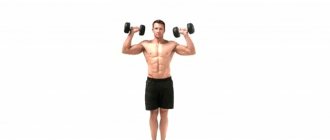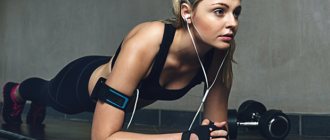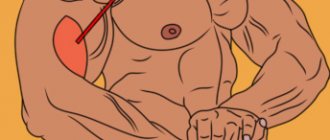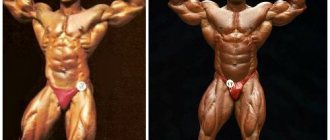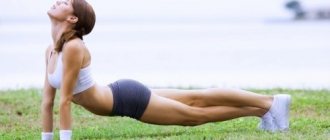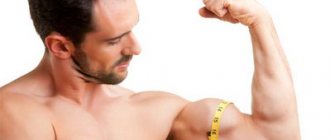Biceps are as simple as five cents
From a biomechanical point of view, when the arm is flexed, the biceps brachii muscle becomes fully tense. That is, there are no special movements to tension the inner or outer head of the biceps. And there are no special exercises to create a biceps peak like the legendary Arnold Schwarzenegger.
The shape of the hand is a genetically determined factor. The peak of the biceps is either present and clearly defined, or it is weakly expressed or absent altogether. You just have to come to terms with this. In any case, well-developed arms look great regardless of their genetically determined shape.
The most important thing is that developing them is not difficult if you do it wisely both from the point of view of physiology and the training process.
What factors cause muscle growth?
Before moving on to the exercises, let's look at the main factors of muscle growth. This is necessary for a clear understanding of the appropriateness of the exercises that we will consider below.
To simplify it as much as possible, muscle development requires building material (amino acids), energy (glucose), hormones (the body synthesizes them in response to training stress) and muscle tension or tension, which initiates growth. Moreover, sufficient muscle tension is the main factor , without which there will be no progress, even if the accompanying conditions are met.
Accordingly, for effective development of muscles, including biceps, it is necessary to create conditions in which there is noticeable muscle tension without unnecessary stress on the ligaments and tendons. This is achieved by using the correct technique for performing the exercise and understanding its biomechanics.
In the case of the biceps brachii muscle, for example, the grip width of the barbell during a classic biceps curl does not matter. Let me remind you that with any bending of the arm, both heads of the biceps are always tense. Thus, the grip should be comfortable to maximize muscle tension with minimal stress on the hands and elbows.
This is much more effective than trying to pump up the outer and inner heads of the biceps separately by varying the grip width. You will spend more time, and due to a grip that is too wide or too narrow, you will overstrain your joints and ligaments, which will not allow you to create sufficient muscle tension. Progress in increasing the weight, and therefore adapting the muscle to the load through its growth, will stop before the size of the biceps begins to please you.
How to pump up biceps at home?
Let's face it: it is impossible to build impressive biceps at home; for this you need some kind of sports equipment, at least dumbbells. In this article we will learn how to train biceps using improvised methods. You won’t pump up the 50 cm “cans”, but you will maintain the current shape. If you have never trained and are just starting your sports journey, then today’s biceps workouts will be very effective for you.
To understand how to pump up your biceps at home, you need to know what this muscle is responsible for. We need the biceps for two actions: raising the arm and turning the hand. Our training will be based on this functionality.
Biceps curl
We will need a backpack (bag) and a towel. You need to stuff the backpack with something heavy, then take a towel and thread it through the top handle. Now we grab the towel so that our palms face each other. Next, we begin to perform biceps curls, as shown in the video.
The exercise must be done smoothly, without jerking. I recommend doing 3-5 sets of 10-15 repetitions.
Concentrated biceps curl
The exercise looks funny, but it will effectively help support your muscles during quarantine. You need to sit on a chair and put your left hand under your right leg. Now lift your leg with your hand as high as possible and lower it as slowly as possible. Below is a video of the exercise:
The same must be done with the other hand. I recommend doing 4-5 sets of 20-25 repetitions.
Reverse grip pull-ups
Reverse grip pull-ups are the most effective exercise for training biceps with your own weight. You need to grab the bar shoulder-width apart with a reverse grip (palms facing you). Next, pull yourself up so that your chin goes over the bar.
I recommend doing pull-ups as many times as possible in 3-4 approaches. During the exercise, you should not help yourself with jerks and swings.
Rotate the brush
We remember that the biceps is responsible for raising the arm and turning the hand. This exercise will help us work our biceps more deeply. You need to take a bottle of water or something heavier, bend your arm 90 degrees and start rotating your hand: clockwise, then counterclockwise.
You can do one approach on each arm, but you need to do it “to failure.”
The most effective exercises for developing biceps
There are only five of them, and in reality three will be enough. Additional exercises are only needed to diversify the training process.
In fact, to effectively develop the biceps brachii muscle, having a barbell and a pair of dumbbells is enough. But you can, in principle, get by with just one barbell and train large biceps with one exercise. Let's start with him.
How can you pump up your biceps without equipment?
It is impossible to pump up your biceps at home only with exercises with your own body weight, but you can do without special exercise equipment like in the gym, and use only barbells and dumbbells or weights. To increase a muscle, it must be contracted with weight, so equipment is an important condition for training. To strengthen the muscle, you can replace dumbbells with exercises on the horizontal bar. Pull-ups with a narrow reverse grip will load the biceps, but the main load will come to the back muscles.
Barbell Curls (Biceps Curls)
The favorite exercise of all young guys who have just reached the gym, along with the bench press. And both of these exercises are usually done incorrectly, which negates any progress.
The main mistake is that the elbows are brought forward , and this cannot be done. The elbows should remain in place, as shown in the video above. In this case, the load falls only on the biceps brachii muscles, and there is no moment of their relaxation in the peak position.
If your elbows are under the barbell, the load will go into them (the force vector is directed downward), and the biceps will relax. Naturally, there is no talk of peak reduction. It is impossible to do it in this position.
As for the grip, grab the bar approximately shoulder-width apart so that your hands do not bend in the horizontal plane. In addition, do not bend your hands towards yourself at the top position of the barbell. They always remain in the same position.
Having raised the barbell to the top position, hold for 0.5 seconds, “squeezing” the muscle into peak contraction. When lowering the projectile down, do not relax your arms and do not fully extend them.
I also recommend using a curved bar, which will allow the hands to be in a natural position, turned inward at about 45°. This practice will prevent them from overexerting themselves as the weight increases.
Lifting dumbbells for biceps while sitting on an inclined bench
An exercise as effective as PSHNB and complements it well on arm day.
The tilt angle of the bench is 45°. The main condition for performing the exercise correctly is keeping the elbow in place when lifting the dumbbell for the biceps .
The biomechanics of the movement are exactly the same as in the biceps curl. When the elbow remains in place, the entire load falls on the biceps brachii muscle and peak contraction can be achieved.
By bringing the elbow forward and actually placing it under the dumbbell, all the load goes from the biceps to the joint. The biceps muscle relaxes, peak contraction is impossible, and muscle tension is completely lost.
To place your elbows in the correct position, just sit on a bench and simply lower your arms with the dumbbells down. This is the starting position and the elbows should remain in this position throughout the entire exercise.
The technique of execution is for the most part similar to that in PSHNB: peak contraction at the top, do not relax your arms at the bottom. You can raise both hands together, or alternately. In the latter case, keep the “resting” arm slightly bent, maintaining slight tension in it.
The difference from PSHNB is only in the supination of the hands. That is, in the lower position the dumbbell is parallel to the body, in the upper position the hand turns outward.
How to quickly pump up your arms
Since the upper limbs consist of many muscle groups, we will briefly consider exercises for each part of the arm.
Small muscles: fingers, hands and wrists
It is not surprising that without tenacious, muscular fingers and strong palms it is impossible to achieve success in many sports.
Listed below are the most effective exercises for training these parts of the arms.
Push-ups on fingers
Such practices were considered the basis during the training of students of oriental martial arts.
Real masters could support their body weight on just a few phalanges.
Technique:
- Place your palms slightly narrower than shoulder width. Shift your weight to your fingers. It is imperative to ensure that your fingers do not bend too much or change their position during movement, otherwise it will be very difficult to avoid injury.
- It is necessary to go down while exhaling, as with the usual type of push-ups, only gradually it is recommended to reduce the number of supporting fingers. If such a load is still too heavy for you, you can lean on your knees.
- It is advisable to touch the floor with your chest while bending your elbows. You need to return to the starting position while inhaling.
Do 2-3 sets of 15-20 repetitions.
Hanging with weights
This seemingly simple exercise can tone the muscles of your hands, forearms and back.
Also, any hanging on the crossbar has a beneficial effect on the condition of the spinal column.
Stages and features:
- Starting position: hanging on a high horizontal bar, palms placed with a straight grip at a distance of about twenty centimeters from each other. You can use a heavy backpack as a weight.
- With straightened legs, trying not to sway, you need to hang for 80-90 seconds.
This exercise greatly pumps up your fingers and strengthens the small tendons of your hand.
Wrist flexion
In this case, you can use dumbbells, kettlebells or a barbell.
You need to do the following:
- Sit on a bench, place your feet shoulder-width apart, straighten your back and slightly tilt your body forward, place your forearms on your hips. Each hand must have a projectile.
- Perform flexion and extension of the wrists, raising the hand with the equipment up and down. It is advisable to linger at the extreme points and change the pace - from fast to slow and vice versa.
Do the exercise for two to three minutes.
Forearms
Pull-ups on fingers
The exercise is considered very difficult, so you can only start it if you have a sufficient level of physical fitness.
Technique:
- Hanging on a high horizontal bar, legs crossed, you can hold the weight on a maximum of three fingers.
- As you exhale, rise up, bending your elbows, and as you inhale, lower down.
You need to do at least two sets of 15-18 repetitions.
Holding a kettlebell with your fingers
You need to hold a kettlebell or other heavy object—barbell plates are most often used.
If the plates are thin, you can only hold them with your fingers to develop grip strength.
Beginners are advised to lift weights while sitting on a bench to avoid accidentally dropping the weight on their feet.
When you are already confident in your abilities, you can hold the kettlebell at waist level in a standing position.
The exercise should take three to four minutes of the static part.
It is better to divide this time into several periods - 70-90 seconds each.
You can train by squeezing a circular expander if you don’t yet risk working with massive equipment.
After lifting weights, it is better to stretch your forearm to relieve tension in the muscles.
Dumbbell Curl
The exercise is very simple and effective. Execution steps:
- Starting position: sitting on a bench, feet shoulder-width apart, a dumbbell in each hand, forearms resting on your hips.
- With your hands with the weights hanging from your knees, you need to bend your wrists, raising and lowering the dumbbells. Any type of grip will do.
Such movements should take three to four minutes in duration.
These elements of arm training will help make your forearms very prominent.
Arms above shoulder: biceps, triceps, brachialis
These muscle groups can withstand very heavy loads.
During training, you can use various equipment: weights, dumbbells, a universal expander, barbell, or train without weights.
"Hammer" with dumbbells
The exercise is aimed at working the biceps. Hammer curls are the basis of a set of workouts with dumbbells at home and in the gym.
The weights must be held with a neutral grip in order to lift them vertically - the axis of the dumbbell must remain perpendicular to the floor.
The exercise consists of the following steps:
- Standing or sitting on a bench, the body needs to be aligned, keeping tense arms pressed to the body.
- As you exhale, you need to bend your elbow, bring the projectile closer to your shoulder and hold in this position for 2-3 seconds.
- You should return to the starting position smoothly and while inhaling.
Minimum number of movements: three sets of 20-25 times.
Concentrated one-arm curls
Another good way to pump up your biceps. You can lift the apparatus alternately with one hand or conduct entire workouts only for the right or left hand, alternating approaches no more than once an hour.
Features and rules of execution:
- Sit on a horizontal surface, resting your palm on your knee. With your other hand, take a dumbbell and hang it from your hip.
- Exhale – bend the elbow and quickly lift the dumbbell to the shoulder.
- Inhale - return to the starting point. It is advisable to do the exercise quickly, while in aerobic mode.
The number of repetitions should reach eighty, divided into several sets.
Dumbbell Bench Press
The triceps, anterior and middle sections of the shoulder, and chest work actively.
The exercise looks like this:
- Lying on a sports bench, your shoulders are on a horizontal surface, your elbows are bent and slightly apart, dumbbells should be placed in your hand above your chest at the level of your collarbones.
- Tightening your muscles, you should forcefully push the shells upward, fully straightening your arms.
- Stay at the top and smoothly bend your arms, returning down.
You need to perform at least two or three sets of 18-22 repetitions.
Lifting the barbell
Works the biceps, brachialis, triceps and upper chest.
Exercise diagram:
- Standing with your feet slightly wider than shoulder-width apart, hold the bar with an overhand grip.
- As you exhale, lift the barbell to your chest, hold at the top and smoothly lower the barbell as you inhale.
You need to lift the barbell ten to fifteen times. You shouldn't overload your muscles, so more doesn't always mean better.
With elastic band
Instead of tape, you can use a universal expander with silicone or rubber ropes. It is necessary to bend your arms while standing on the band - this will work the biceps, brachialis, muscles of the forearm and chest.
Execution steps:
- Stand in the middle of the expander so that your legs become the point of application of the elastic forces of the elastic bands. Hold the projectile handles tightly in your palms.
- With your knees bent, you should bring your hands closer to your collarbones.
- Stay at the highest point for two to three seconds and return down while inhaling.
It is better to wear protective gloves to reduce the risk of injury to your palms. Perform a minimum of 2-3 sets of 20 times.
French press with dumbbells
This exercise is considered a classic for pumping up and stretching all triceps heads.
The upper chest is also well used.
The procedure is as follows:
- You can stand or sit with your shoulder blades together. Keep your arms bent at the elbows above your head so that the dumbbells touch your shoulder blades.
- As you exhale, straighten your arms, pushing out the dumbbells, and lower yourself down, making several springing movements.
- Bring your hands back as you inhale.
The minimum number of times is 2-3 sets of 20-25 series.
Diamond push-ups
“Diamond” is a triangle that should be between the palms when they are on the floor.
To work the brachialis, biceps, back and shoulders, you need to connect your thumbs and index fingers.
You need to do the following:
- The legs are next to each other, the palms are connected in a triangle, the elbows are pressed tightly to the sides.
- Exhale – bend your arms, preferably touching your chest to the floor.
- Inhale – return to the starting position.
Do 3-4 sets of at least 20 repetitions. Ideally, you need to do 100 push-ups
Backward push-ups
In this case, the brushes must be installed on some elevation.
The triceps, back, forearm and back of the thighs receive a very good load.
The exercise consists of several steps:
- Place your hands above floor level, shoulder width apart. The face should be directed upward, the heels should be firmly planted on the floor.
- Bend your arms and lower yourself down so that your back remains straight and your legs are straight at the knees. You should lower while inhaling and as low as possible.
- As you exhale, return to the starting position, straightening your upper limbs.
Minimum number of repetitions: 3-4 sets of 22-25 repetitions.
Shoulders
The brachialis muscle consists of several sections due to the interweaving of fibers.
In total, there are three types of brachial (deltoid) muscle bundles: anterior, middle and posterior. Let's briefly look at the basic deltoids exercises.
Kettlebell Snatch
A great way to get a full-body workout is to do the kettlebell snatch.
It consists of five steps and is performed as follows:
- Start. You need to stand straight, with your feet shoulder-width apart. The kettlebell is located nearby, the handle is parallel to the athlete’s body. You must use an overhand grip. Your knees should be bent, your torso should be slightly tilted, and your free arm should be pulled back.
- Swing. With your knees straight, you need to lift the weight and swing between your legs.
- Detonation. You should quickly straighten your torso and legs, as a result the weight is pushed up with force. Thanks to inertia, the hand does not participate in lifting the projectile.
- Podsed. When your back straightens, you need to sit under the apparatus. The weaker the detonation, the deeper the element must be performed at this stage. The equipment should go behind the forearm so as not to damage the hand. Getting up from the afterbirth is allowed only without sudden movements.
- Fixation. When the weight is at the very top, you need to stay in this position, extending your free arm to the side for balance.
The whole complex is carried out similarly on the other hand. The execution time should not exceed 35-50 seconds.
Dumbbell lateral raises
This exercise is aimed at all parts of the brachial muscle, but the rear deltoids are best pumped.
They give width to your shoulders, so you can’t do without this exercise if you want to look “powerful.”
Characteristics of the stages:
- Standing bent over, back straight, feet at a distance of double hip width, arms with dumbbells straight and lowered down.
- As you exhale, you need to raise your limbs to the side to shoulder level, stay in this position for 2-3 seconds and lower the dumbbells as you inhale.
Do three sets of 20-25 reps.
Pull-up by the head
All shoulder bands, biceps, brachialis, back and chest are trained.
The correct technique is as follows:
- Hanging on a high horizontal bar, hands with a straight grip, arms and legs straight. It is necessary to take a position so that the spine is strictly under the crossbar.
- As you exhale, you need to rise up until your shoulder blades come together. The head should almost touch the crossbar with the back of the head.
- As you inhale, you should smoothly lower down.
This part of the workout is considered difficult even among advanced and amateurs. It is not suitable for beginners.
Recommended load: two sets of 10-15 pull-ups.
Hammer Grip Dumbbell Curls
This exercise is mainly aimed at developing the small muscle between the biceps and triceps - the brachialis .
It gives the arm a more impressive, athletic shape, so to speak, increases its thickness and has a good effect on the development of overall strength of the shoulder and forearm.
We perform the exercise standing, shoulder blades retracted, elbows held in a natural position at body level, do not move forward, perform a peak contraction at the top, do not relax the arms at the bottom.
You can raise both arms at once or alternately, without fully extending them at the bottom. In the latter case, we maintain a slight tension in the “resting” hand.
Standing dumbbell curl
An alternative to doing dumbbell curls while sitting on an incline bench.
The technique of performing the exercise is similar to that of lifting dumbbells for biceps with a “Hammer” grip, but there is supination of the hand in the upper position.
The shoulder blades are brought together, we keep the elbows at body level, we don’t move them forward, we do a peak contraction at the top, and we don’t relax the arms at the bottom.
You can raise both arms at once or alternately, without fully extending them at the bottom. In the latter case, we maintain a slight tension in the “resting” hand.
Working in a biceps machine
Another alternative to the classic biceps curl. Often people prefer this particular exercise, considering it more effective, since they “feel the muscle” in it better.
In fact, we are talking only about rigid fixation of the elbows and a clearly defined amplitude, which does not provide freedom in movement for performing the exercise incorrectly. If you perform PSNB with the technique described above, you will feel the muscle just as well.
However, there are a few important rules when working with a biceps machine. So, the shoulder should lie completely on the pillow, avoid just resting on the elbows. To do this, select the desired seat height.
In addition, do not fully extend your arms, maintaining tension in them. In the top position, do not bend your hands towards yourself; they remain straight all the time.
Exercises for the lower chest
Dips
Regular parallel bar push-ups also help pump up your chest. Before you begin this part of the workout, you need to be able to do a handstand on the parallel bars for at least four minutes.
Push-up nuances:
- Starting position: standing on your hands, elbows straight, legs bent at the knees, shins pressed against each other.
- As you inhale, you should go down as low as possible, and as you exhale, straighten your elbows and rise up.
Do a total of 60-70 repetitions, divided into 3-4 sets.
How to train biceps
The biceps is a small muscle, but actively works in almost all deadlifts as a synergist. That is, it helps the back muscles, for example, in pulling a barbell to the stomach or pulling a block to the chest. Accordingly, it is easy to overtrain if this factor is not taken into account. In a permanently overtrained state, naturally, nothing will grow.
For the effective development of any muscle group, it is advisable to give it enough time to recover, and then load it with a certain frequency. On average, recovery time ranges from 48 to 72 hours.
In the case of biceps, an excellent option is when in one workout in a weekly microcycle they are loaded only as synergists, and in the second there is a separate arm workout with a couple of exercises directly on the biceps muscle.
There are actually a lot of schemes, both for a 3-day split and for a 4-day one. It is important to understand the principle itself, which I will describe using the example of a microcycle below.
DAY 1: Back + Triceps DAY 2: REST DAY 3: Legs + Shoulders DAY 4: REST DAY 5: Chest + Biceps DAY 6: REST DAY 7: REST
On the first training day, the biceps works as a synergist in back exercises (plus the rear delta), while the triceps are fully pumped.
On the second training day, we load our legs and shoulders to give our arms a good rest.
On the third training day, the triceps work as a synergist (plus the anterior deltoid) in chest press exercises, and the biceps are trained fully (PSNB + seated dumbbell lifts + Hammer). Thus, the arms are worked out twice a week and still have time to recover well.
As for the training protocol, vary the number of repetitions in biceps exercises from 8 to 15, and the number of approaches - up to three working sets. Don't forget about a good warm-up, gradually increasing the load and cycling. You can read about this in detail in the feature article.
How to pump up your forearms
I will have a separate interesting article about the forearms, but now I will say a couple of main points.
You know, as a rule, if a person asks me about how to pump up his forearms, then his level of fitness leaves much to be desired.
The lower a person’s level of fitness, the more concerned he is with the issue of training small muscle groups.
Friends, understand that if you grow large muscle groups, then your forearms will grow themselves! The vast majority do not need any special exercises for the forearms!
It's like trying to build a skyscraper on the foundation of a cowshed.
When doing any arm exercises, your forearms always work.
If you still want to know how to train your forearms, then here is a set of the most effective exercises:
- Wrist curls with a barbell.
- Reverse grip barbell curls.
- Pronation and supination (turning the hands outward and inward).
- Squeezing the expander.

